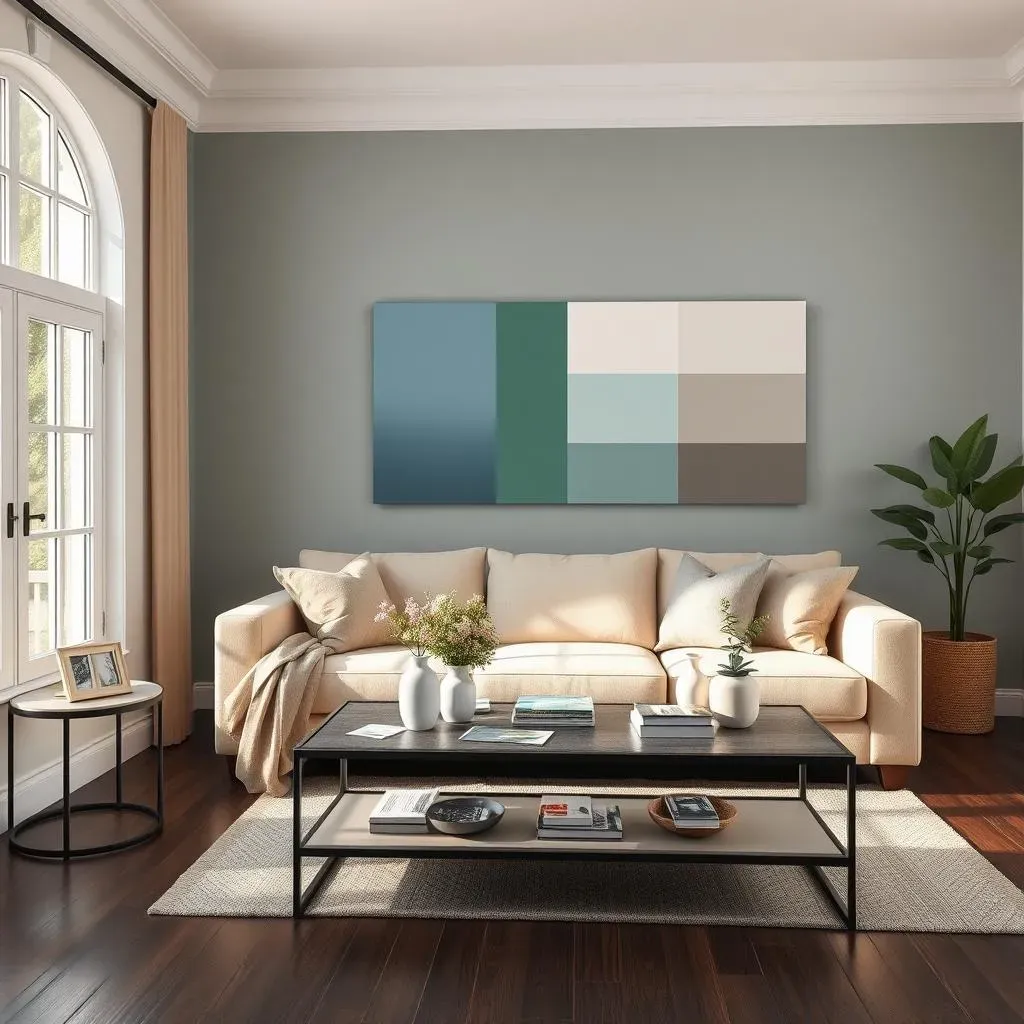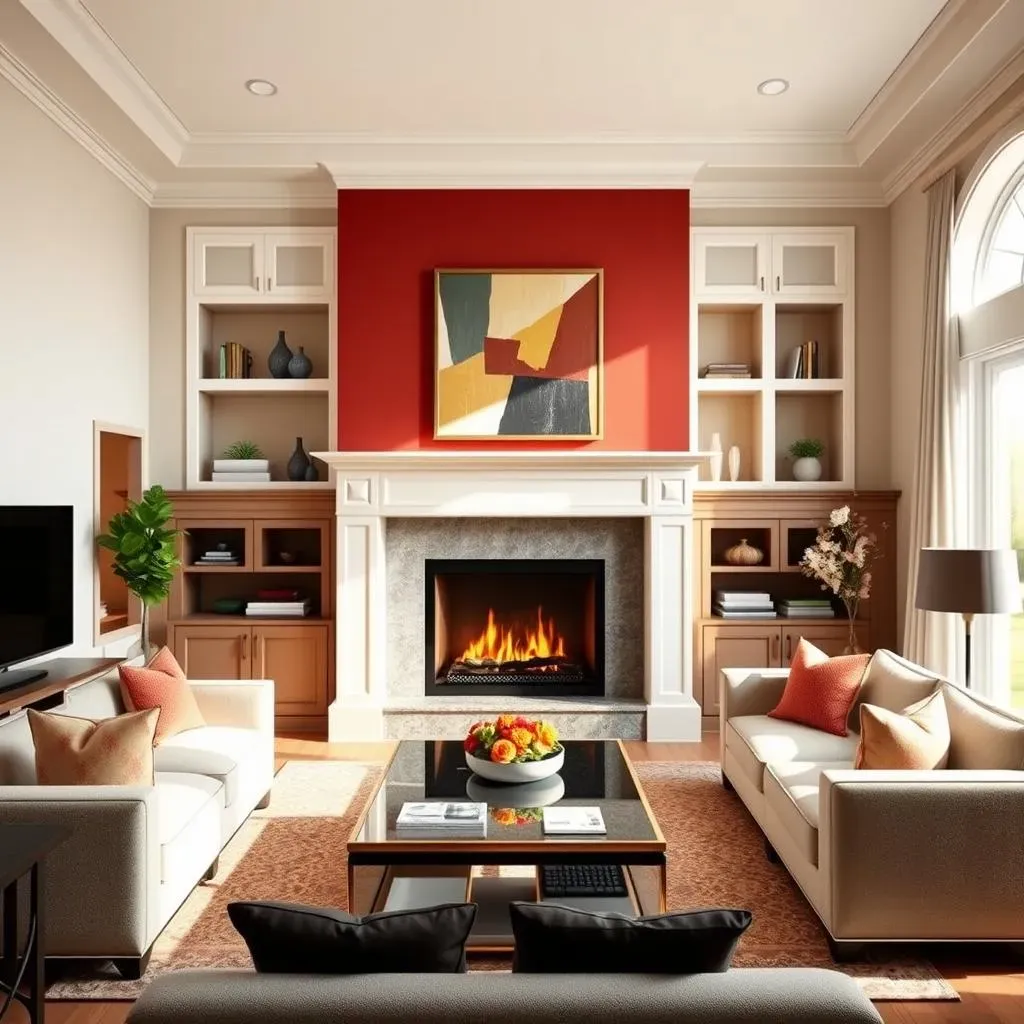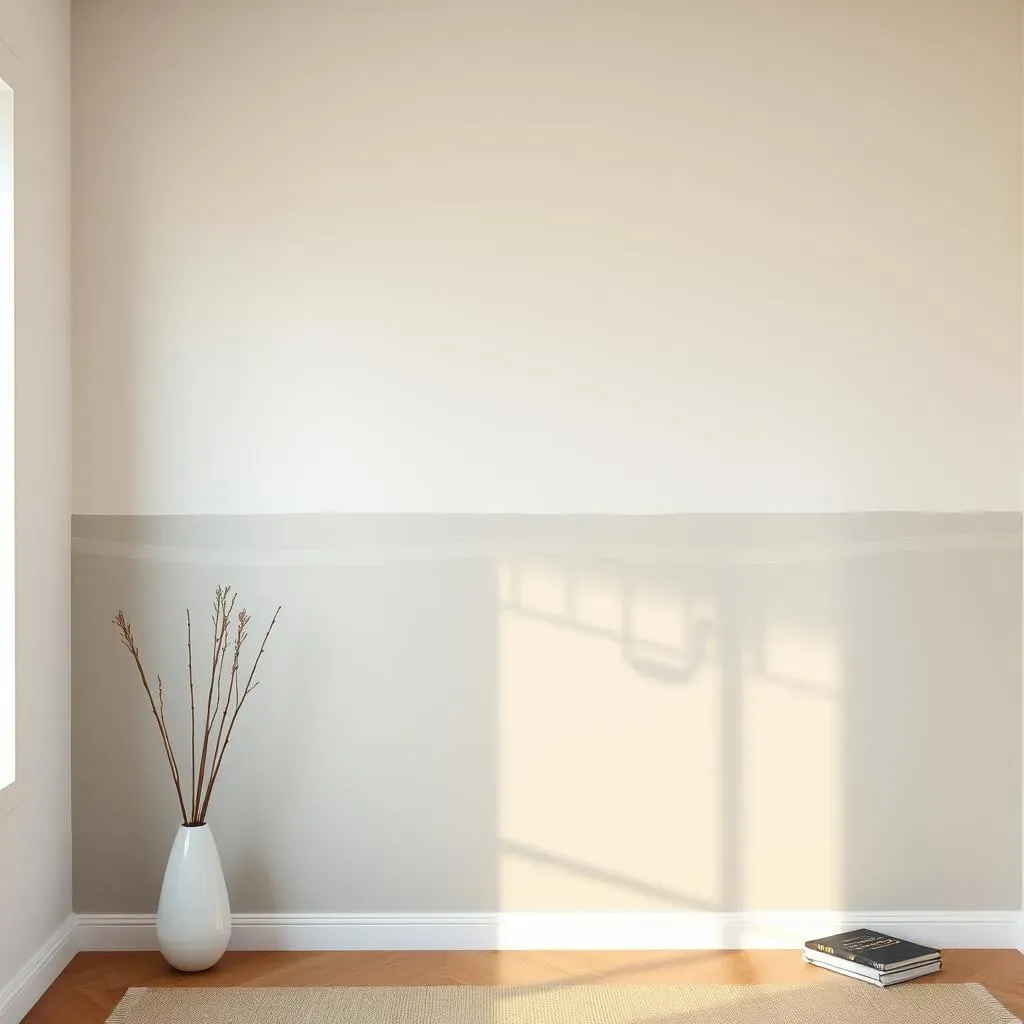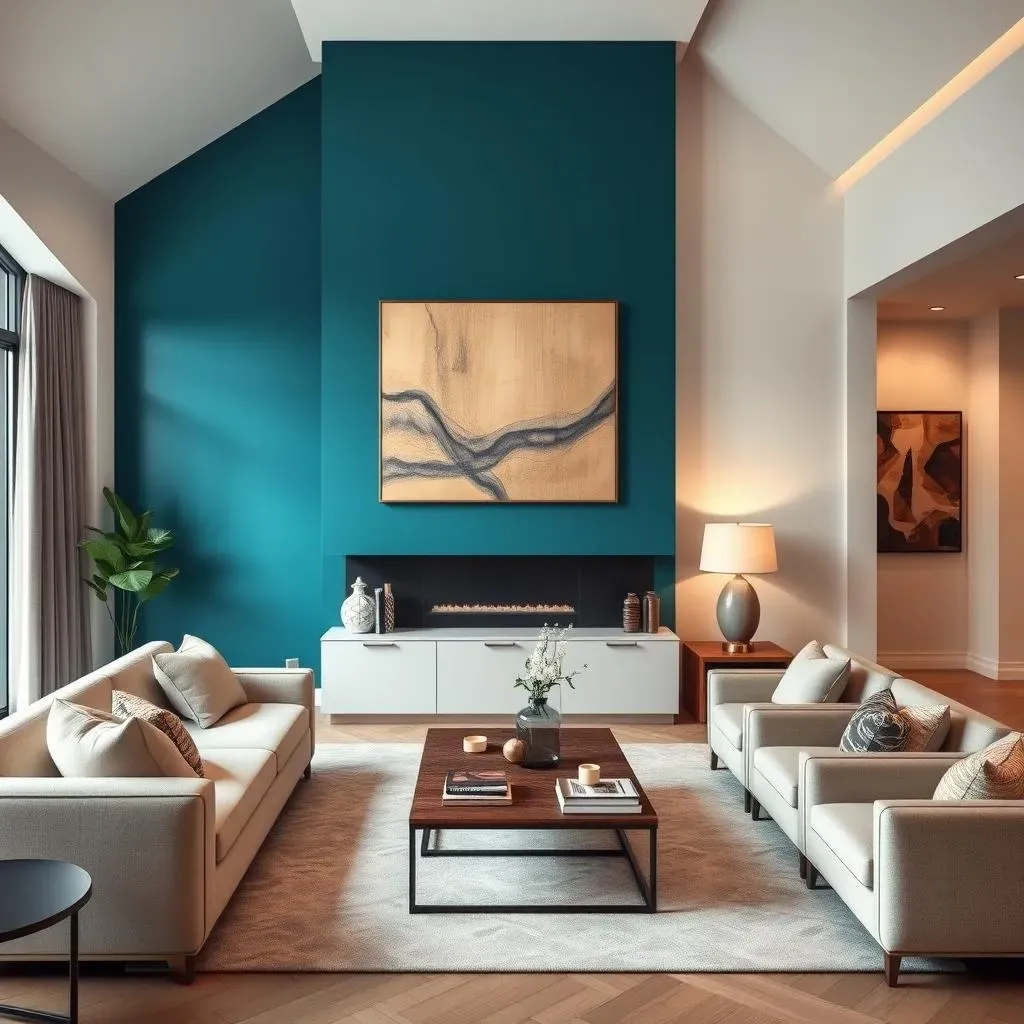Table of Contents
Ready to give your living room a stunning makeover without breaking the bank? Then you've come to the right place! This article is your ultimate guide to discovering the magic of "living room accent wall ideas with paint." We'll explore a world of creative possibilities, from choosing the perfect paint color to mastering easy DIY techniques that will transform your space. Get ready to be inspired as we delve into various design styles, covering everything from subtle and sophisticated looks to bold and dramatic statements. We'll equip you with practical tips and tricks, guiding you through each step of the process, from color selection and preparation to achieving a professional-looking finish. Whether you're a seasoned DIY enthusiast or a complete beginner, we'll show you how to create a focal point that elevates your living room's style and personality. So, let's embark on this exciting journey together and discover the perfect paint accent wall for your dream living room!
Choosing the Perfect Paint Color for Your Living Room Accent Wall

Choosing the Perfect Paint Color for Your Living Room Accent Wall
Considering Your Room's Existing Palette
Picking the right paint color is like choosing the perfect outfit – it needs to complement everything else! Start by looking at your existing furniture, flooring, and other décor. Are your floors dark hardwood? A lighter accent wall might brighten the space. If you have a lot of warm tones (browns, oranges), a cool-toned accent wall, like a calming blue or a sophisticated grey, could add a nice contrast. Or, if you're aiming for a more cohesive look, choose a color that picks up on existing hues in your furniture or rugs. For instance, if you have a beige sofa, a slightly deeper beige or a creamy off-white could create a subtle yet elegant accent wall.
Don't forget about the amount of natural light your room gets! A north-facing room with limited sunlight might benefit from a warmer, brighter color, while a south-facing room flooded with light can handle a deeper, more dramatic shade. Experiment with different shades using online tools or paint swatches to get a feel for how they will look in your specific lighting conditions. Remember, a small sample of paint goes a long way in helping you make the right decision!
Room Lighting | Recommended Color Palette |
|---|---|
Low natural light | Warm, light colors (cream, beige, light yellows) |
Abundant natural light | Cool, deeper colors (blues, greens, grays) |
Adding Personality and Style Through Color
Now for the fun part: expressing your personality through color! Think about the mood you want to create in your living room. Do you crave a relaxing and serene atmosphere? Then soft blues, greens, or lavenders might be your perfect match. Aiming for a bold and energetic vibe? Consider rich jewel tones like emerald green, sapphire blue, or ruby red. Or maybe you prefer a more sophisticated and modern look? Neutrals like grey, beige, or taupe can create a timeless and elegant backdrop, while adding pops of color through accessories. If you're feeling adventurous, you can even explore more unconventional choices, like a deep charcoal grey or a vibrant mustard yellow, for a truly unique accent wall.
For a touch of inspiration, browse through interior design magazines or websites like Pinterest. Look at living rooms with similar layouts and styles to yours, paying attention to the paint colors used on accent walls. Check out these other great ideas for a stunning living room, from modern accent walls to options that incorporate a TV. Remember, the right paint color can completely transform the feel of your living room, so choose wisely and have fun with it!
- Relaxing: Soft blues, greens, lavenders
- Energetic: Jewel tones (emerald, sapphire, ruby)
- Sophisticated: Neutrals (grey, beige, taupe)
Creating a Focal Point: Living Room Accent Wall Design Ideas with Paint

Creating a Focal Point: Living Room Accent Wall Design Ideas with Paint
Highlighting Architectural Features
Let's talk about creating a focal point! The easiest way to use paint to draw the eye is by highlighting existing architectural details. Got a fireplace? Paint the wall around it a striking color that pops against your other walls. Love those built-in bookshelves? Give them a fresh coat of paint in a complementary shade to make them stand out. Even simple crown molding can be dramatically enhanced with a contrasting color. Think of it as adding a frame to a beautiful picture – it draws attention to the main subject.
Consider the size and shape of your living room. In a small space, a lighter accent wall can make the room feel bigger and brighter. Conversely, a dark accent wall in a large room can add depth and drama. For example, a deep navy blue can work wonders in a spacious living room with lots of natural light. Check out these inspiring ideas for small living rooms: small living room ideas .Remember, the goal is to create balance and visual interest, so think about the overall flow of the room when making your choices.
Architectural Feature | Paint Color Suggestion |
|---|---|
Fireplace | Bold, contrasting color |
Built-in shelves | Complementary shade |
Crown molding | Contrasting or accent color |
Strategic Placement for Maximum Impact
Where you place your accent wall significantly impacts its effect. The most common choice is the wall behind the sofa, creating a stunning backdrop for your seating area. This is a classic choice for a reason—it's effective and visually pleasing. But don't feel limited! If you have a large window wall, a contrasting accent wall can create a beautiful balance. Or, if you have a particularly interesting piece of art, consider painting the wall behind it to make it a true statement piece.
Think outside the box! Sometimes, the best accent walls aren't even full walls. A half-wall, painted a different color, can create a unique visual separation in an open-plan living area. Or, consider painting a feature wall, like a long hallway wall, with a bold pattern or color to create a dramatic entrance. For more inspiration on modern living room styles, check out our guide on modern living room ideas.
- Behind the sofa
- Opposite a large window
- Behind a statement piece of art
- Half-wall in open-plan spaces
Incorporating Patterns and Textures
Beyond solid colors, you can add texture and pattern to your accent wall using paint. Stenciling is a fantastic way to add a unique touch, allowing you to create geometric patterns, floral designs, or even custom artwork. This adds a level of sophistication and personality that a simple color can't always achieve. Consider using painter's tape to create stripes or other geometric shapes. This is an easy DIY project that can dramatically change the look of your room.
Another great way to add visual interest is by using a textured paint. Textured paints come in various finishes, from subtle to highly dramatic. They can add depth and dimension to your accent wall, giving it a luxurious and unique feel. Consider how the texture will interact with your existing décor. A highly textured wall might not be the best choice if you already have a lot of busy patterns in your living room. For more ideas on incorporating TVs into your accent wall design, visit our page on accent walls with TVs.
Easy DIY Living Room Accent Wall Painting Techniques

Easy DIY Living Room Accent Wall Painting Techniques
Prep Work: The Foundation for a Perfect Paint Job
Before you even think about touching a paintbrush, proper preparation is key! This isn't just about slapping some paint on the wall – it's about achieving a professional, long-lasting finish. First, clean the wall thoroughly. Dust, cobwebs, and grease can interfere with the paint's adhesion, leading to a patchy finish. Use a damp cloth or sponge to wipe down the surface, paying attention to any particularly grimy areas. Once it's dry, use painter's tape to mask off any areas you don't want to paint, like trim or ceiling edges. Trust me, this extra step will save you a lot of headaches (and potential repainting!) later. A crisp, clean line between your accent wall and the rest of the room is a sign of a truly professional job. And speaking of professional, for some more inspiration on modern living room designs, check out our article on modern living room accent walls.
Next, fill any holes or cracks in the wall using spackle or patching compound. Once it's dry, sand it smooth to create a seamless surface. This is especially crucial if you're using a darker paint color, as imperfections will be more noticeable. After patching, give the wall another quick clean to remove any dust from sanding. This seemingly small detail will make a huge difference in the final result. A smooth, even surface allows for better paint application and a more professional-looking finish. If you're looking for some more ideas on how to incorporate a TV into your accent wall design, check out our guide on living room accent walls with TVs.
Prep Step | Tools/Materials |
|---|---|
Cleaning | Damp cloth, mild detergent |
Masking | Painter's tape |
Patching | Spackle, putty knife, sandpaper |
Painting: Techniques for a Flawless Finish
Now comes the fun part—actually painting the wall! Start by stirring your paint thoroughly to ensure even color and consistency. Use a high-quality roller and brush for the best results. Apply thin, even coats, allowing each coat to dry completely before applying the next. Two coats are usually sufficient for most paints, but you might need more for highly pigmented colors or if you're covering a significantly different color. Remember, thin coats are better than thick ones, as they dry faster and are less likely to drip or run. Take your time, and don't rush the process. For a truly professional look, use a small brush to cut in around the edges before rolling. This will give you clean, sharp lines that make all the difference.
For a unique look, consider using a technique like color washing or sponging to add subtle texture and depth. These techniques are easy to master and can add a lot of visual interest to your accent wall. If you're feeling adventurous, try experimenting with different painting tools, like a sea sponge or a rag, to create interesting patterns and effects. Don't be afraid to get creative and have fun with it! And when you're done, stand back and admire your handiwork. You've just transformed your living room with a stunning DIY accent wall! For even more ideas on accent wall styles, explore our collection of accent wall ideas with wallpaper.
- Stir paint thoroughly
- Use high-quality roller and brush
- Apply thin, even coats
- Allow each coat to dry completely
Beyond the Basics: Advanced Living Room Accent Wall Ideas with Paint

Beyond the Basics: Advanced Living Room Accent Wall Ideas with Paint
Creating a Feature Wall with Bold Geometric Patterns
Let's step up the game! Forget simple stripes; we're talking about creating a true statement piece with bold geometric patterns. Think chevron, herringbone, or even complex tessellations. This requires a bit more planning and precision, but the results are breathtaking. You can achieve this using painter's tape and multiple colors, creating a striking design that adds depth and visual interest. Start by sketching your design on the wall lightly with a pencil to ensure accuracy. Then, carefully apply the painter's tape, creating clean lines for your pattern. Use a high-quality brush for sharp edges and even color application. Remember, patience is key here! Taking your time will ensure a flawless, professional-looking finish. For more inspiration on creating a focal point, check out our article on modern living room ideas.
For an even more sophisticated look, consider incorporating metallic accents into your geometric design. A touch of gold, silver, or copper can add a luxurious feel and elevate your design to the next level. You can achieve this by using metallic paint pens or even metallic painter's tape. Experiment with different color combinations and metallic finishes to find the perfect look for your living room. Remember, the possibilities are endless! Don't be afraid to push your creative boundaries and create a truly unique and personalized accent wall. For some ideas on how to incorporate a TV into your design, see our post on TV accent walls.
- Chevron
- Herringbone
- Tessellations
Ombre and Gradient Effects for a Subtle Statement
Want something more subtle yet equally stunning? Consider creating an ombre or gradient effect on your accent wall. This involves a gradual transition between two or more colors, creating a soft, dreamy look that adds depth and sophistication. You can achieve this by using multiple shades of the same color, creating a seamless blend from dark to light, or by blending two complementary colors for a more vibrant effect. The key is to use a sponge roller or a brush with a soft, feathery edge to blend the colors smoothly. Start by painting the darkest shade at the top or bottom of the wall, depending on your desired effect. Then, gradually blend in lighter shades, using overlapping strokes to create a smooth transition. This technique requires a bit of practice, but the results are well worth the effort. For even more wallpaper ideas, see our article on wallpaper accent walls.
To enhance the ombre effect, consider using a slightly textured paint for added depth. A subtle texture can help to diffuse the color transitions, creating a more natural and organic look. You can also experiment with different lighting to highlight the gradient effect. For example, using spotlights to accentuate the color changes can create a dramatic and eye-catching display. Remember, the beauty of this technique lies in its simplicity and elegance. It's a subtle way to add personality and visual interest to your living room without being overwhelming. For more ideas on small living room designs, check out our article on small living room accent walls.
Technique | Description |
|---|---|
Ombre | Gradual transition between two or more colors |
Gradient | Smooth blend of colors |
